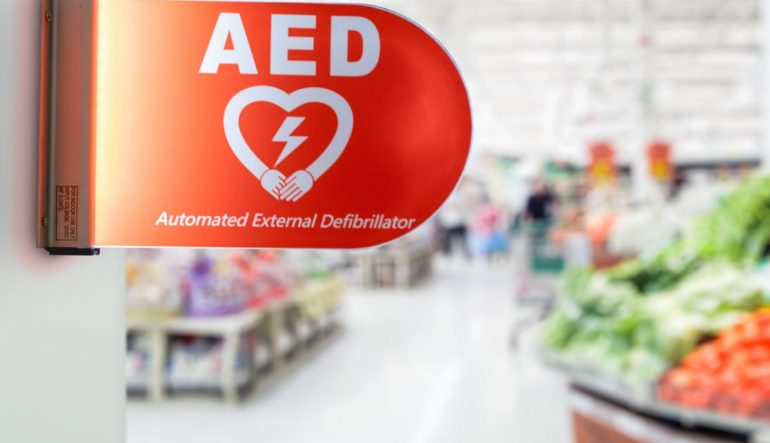Cost effectiveness of public access defibrillation
During our recent conversation, economist Dr Anthony Ockwell talked about the importance of public access defibrillation when it comes to saving lives from sudden cardiac arrest.
Dr Ockwell was discussing his work calculating the economic impact of lives prematurely lost to sudden cardiac death.
Based on 2017/18 data, his finding was that the economic impact on Australian society of sudden cardiac death is AU$50.2 billion each year – in lost productivity, earnings and personal impact on families and communities.
From this finding, he naturally concluded that we have a shared responsibility to reduce that burden, and do what we can to improve chances of surviving sudden cardiac arrest.
This in-part, requires improving public access to defibrillation.
Why defibrillation?
Say you were to experience a sudden cardiac arrest right now. For every minute that you go untreated, your chances of survival decrease by 10 per cent.
This is why the global survival rate of sudden cardiac arrest is estimated to be lower than one per cent.
When someone experiences a sudden cardiac arrest, an AED (automated external defibrillator) needs to be placed on their bare chest within three to five minutes of their collapse.
For this to occur, someone needs to have seen the cardiac arrest happen.
According to the Chain of Survival, that witness needs to recognise – and act on – the need to immediately call emergency medical services (EMS). They then need to commence CPR (cardiopulmonary resuscitation) and, for the best chances of survival, apply defibrillation.
More than any other cardiac arrest resuscitation intervention, rapid defibrillation gives the patient their best chances of survival.
RELATED ARTICLE: CPR and defibrillation saves lives
Herein lies the challenge.
AEDs are typically scarce in most public places – and are rarely to be found in homes, where approximately 80 per cent of all sudden cardiac arrests occur.
When they are used, they are effective. This study attributed a 66.6 per cent out-of-hospital cardiac arrest survival rate for patients who were treated with a public access defibrillator, before emergency services arrived.
Dr Ockwell estimated that during 2017/18, some 4,500 public access defibrillators were available in the Australian State of Victoria. Over that period, some 30 lives were saved by bystanders across Victoria.
By those numbers, a single defibrillator had a 150:1 chance of being used to save a life over that time.
These findings reflect what we know about public access defibrillator use. For example, this study reported a successful public access defibrillator deployment rate by bystanders of 1.74 per cent.
Why so low?
Critics of public access defibrillation cite low use rates as proof of their claims.
A further complication is that even when an AED is near to the site of a sudden cardiac arrest, there is no guarantee it will be used.
Another key issue is, are they located near enough to where people are likely to experience cardiac arrests?
In the 1990s, casino security guards and American Airlines flight attendants showed that having AEDs near where people were likely to experience sudden cardiac arrests, made massive differences to survival rates.
The challenge is, most sudden cardiac arrests occur in homes.
This has been exacerbated by COVID-19. For example, a systematic review of data from Spain, Australia, USA, Italy and France found that, over the course of 2020, rate of cardiac arrests in homes increased from 72.8 per cent before the pandemic, to 84 per cent during the pandemic. It also showed that overall AED use by bystanders nearly halved, from 12.4 per cent to 6.8 per cent.
The fact is, to be cost-effective, public access defibrillators need to be used. Lack of knowledge of their presence, and their location outside proximity to likely cardiac arrests, are contributors to underuse.
What’s the opportunity?
Therein lies the opportunity: to get better at placing defibrillators where they’re most likely to be used, and improve public awareness of their location.
Within Dr Ockwell’s recommendations was the need to make it easier for bystanders to find and access AEDs.
There are many successful examples of such apps and services. GoodSAM, Heartrunner and PulsePoint AED have all done a spectacular job demonstrating what is possible in this regard.
A key opportunity however, is improving household access to defibrillation.
Ultimately, transitioning from the idea of public access, to personal access defibrillation, is the goal.
This will require making individual AEDs more affordable, easier to use, and more accessible for households,
Dr Ockwell’s research averaged the economic value of an Australian life prematurely lost to sudden cardiac death at a little over AU$2 million.
He also determined that for every dollar spent on public access defibrillation, a seven-dollar return is delivered back to society.
From an economic perspective, this sends a clear signal to policymakers on the need for better access to defibrillation in communities.
It also makes a strong case for ensuring households have better access to the tools they need to save lives.
RELATED ARTICLE: How many lives can we save?



